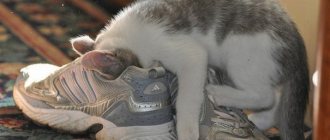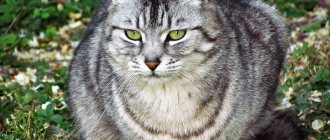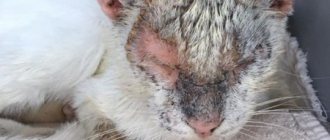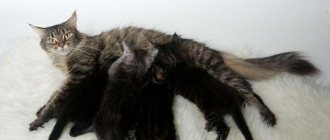(Be the first to vote!)
5589564
12/14/2021 owner reviews 1,
We all know that cats shed, and that it's normal to have cat fur on your couch and clothes. However, it is important to know the difference between normal and abnormal hair loss. Thinning or hair loss in cats, also known as alopecia, on the back legs can be caused by a number of problems: fleas, allergies, bacterial infection or stress.
- Why do cats lose hair on their back legs? Fleas and other parasites
- Pain
- Allergies
- Stress and anxiety
Alopecia, or feline hair loss: what is it?
All cats shed twice a year, and this is the norm. How to distinguish: is it molting (the process when the fur is renewed) or pathology (baldness of the animal)? To do this, you need to know how the disease manifests itself, what its prerequisites are and in what cases the owner needs to sound the alarm.
Alopecia is the name given to abnormal hair loss in cats, as a result of which bald spots are formed on the animal's body - areas with absolutely no hair. The fur may fall out in clumps, forming bald areas on the animal's head, ears, and paws. Having noticed such areas, the owner should immediately take the pet to an appointment with a veterinarian. Baldness can be a signal of serious problems in the animal’s body.
But this should not be confused with hair loss, which normally occurs in all healthy felines. Cats lose their fur during:
- molting (a seasonal change of “coat” occurs twice a year; cats usually shed more than males);
- stress (the animal may shed some hair due to excitement);
- age-related changes (old animals lose hair and whiskers);
- frequent bathing (this is why it is recommended to bathe the animal only if necessary; twice a year is quite enough).
At the same time, the wool does not come out in clumps, without forming bald spots. But the disease has slightly different symptoms.
Problems with the endocrine system
Alopecia, caused by disturbances in the endocrine system of cats, is not so rare. The specific endocrine disease may vary. Additional symptoms of hypothyroidism are lethargy, sometimes obesity, and decreased body temperature.
With hyperfunction of the adrenal cortex, swelling appears. What bald cats look like due to the endocrine system can be seen in the photos of special sites about feline health; accurate illustrations will help owners quickly recognize the disease in order to begin its treatment.
Alopecia symptoms
You can recognize alopecia in a pet by the following signs:
- The fur falls out excessively, in clumps. Bald spots in cats appear mainly behind the ear, in the neck, back, and on the tail.
- The skin in these places may have its usual pink color or turn red, sores or scabs may appear there.
- Check your pet's reaction to touching the bald spot: perhaps the spot hurts or itches.
- Check if the animal has symmetrical bald spots.
If you notice these symptoms, you should urgently seek professional help from a veterinarian. Otherwise the disease will progress.
General information, predisposing factors
This is the name of a skin disease of inflammatory etiology, which is accompanied by a rash, peeling of the skin, as well as the release of ichor and exudate (especially in places of folds) . The area of the muzzle, ears, neck, interdigital spaces, and, less commonly, other areas of the skin are severely affected. Veterinary statistics indicate that the disease is more common among kittens under one year of age, but (in much rarer cases) it also occurs in adult cats.
What are the causes of the disease? Such dermatitis is not contagious (however, it all depends on the root cause), it can be transmitted genetically, occur due to disruption of the digestive system (for example, intestinal dysbiosis), as well as due to contact of the skin and external irritants (household chemicals, pollen, paint products, etc.). Dermatitis is widespread in areas with high levels of environmental pollution. In particular, it is much more common in cats living in houses directly adjacent to streets with heavy traffic.
Causes of this disease
If an animal has bald spots on its body and head, this may be a sign of a food allergy. Allergies should be looked for in your pet's diet. They can be:
- Proteins of animal and plant origin;
- Various cereals;
- Meat – in particular lamb.
In addition, it may be an allergic reaction to flea bites, cigarette smoke or other odors (inhalation allergy).
The causes of baldness may lie in the psychological state of the pet, that is, hair may fall out due to stress. If the veterinarian diagnoses this reason, then the first thing the owner needs to do is find out what kind of stress or experience the pet has had recently, eliminate it, and only after that give sedatives, which only in this case will be effective. Symptoms of alopecia of a psychogenic nature are bald patches that are located on the thighs, abdomen or paws.
The causes belonging to the third group are infectious. If a cat's hair is falling out, the culprit may be scabies, lichen, fungus, or mites. If a cat has a bald spot behind its ear, it could be ringworm. There are several varieties: fungal (another name is ringworm; contagious to humans), psoriasis or eczema, viral.
Hair mites can also cause hair loss. They are very small and impossible to notice with the naked eye. Lice eaters do not live long, but they reproduce very quickly.
If your cat has bald spots on its neck, the cause may be dermatitis. It can be caused by various chemical and biological factors. Even treatment for parasites can cause hair loss.
Hair loss can be a consequence of seborrhea, a disease in which the functioning of the sebaceous glands is disrupted. This is usually indicated by baldness in a cat near the tail. That is why this disease is sometimes called “greasy tail”.
Another group of problems that cause baldness is disruption of the hormonal system:
- thyroid problems, manifested by both increased and insufficient levels of hormone production;
- diabetes;
- malfunctions of the adrenal glands, in particular their hyperfunction.
Other reasons include the presence of tumors in the animal, genetic predisposition and reactions to medications. Thus, a kitten’s bald spot may appear due to the fact that during pregnancy its mother did not receive various essential minerals and vitamins.
Clinical picture
This disease is characterized by a relapsing course with exacerbations that occur more often in the warm season (more microorganisms). The main signs are: severe itching, which is why a sick cat can scratch the skin vigorously, sometimes until it bleeds; rashes on the affected skin, peeling, flaking; dry skin all over the body. Blisters and papules gradually form on the skin. They open, resulting in a large amount of ichor flowing onto the skin. Being contaminated with pathogenic and conditionally pathogenic microflora, the exudate begins to decompose and smell bad. All this not only causes your pet severe pain, but can also cause the development of septic phenomena.
Diagnosis of the disease
If a cat's hair falls out in clumps before bald spots form, it should definitely be seen by a specialist. Only a veterinarian can accurately determine the diagnosis. To determine the disease and prescribe the correct treatment, the doctor must:
- Find out how and when the disease manifested itself. The owner will have to tell in great detail the animal’s lifestyle, what the pet ate and drank, what it came into contact with, and whether it walked outside.
- Examine the patient.
- Examine hair roots under a microscope.
- You may need blood and hormone test data, and a scraping will be required.
- Sometimes an ultrasound or x-ray is done to confirm or rule out the presence of tumors.
Other causes of bald spots and hair loss
Listed are the main reasons why a cat’s coat may most often thin out. But veterinarians, upon careful examination of the animal, can detect other sources of baldness.
The thickness of the coat in pregnant females changes, and problems with hair can also arise in diseases such as ringworm, solar and neurogenic dermatosis, folliculitis, acne, erythema multiforme .
ATTENTION! All causes are serious and self-medication is excluded. Even if the doctor sends the cat for treatment at home, he will diagnose and prescribe professional, effective treatment.
Treatment of hair loss in cats
Hair loss in cats is a serious but completely treatable disease. Treatment must be selected individually. What medications the doctor will prescribe depends on the causes of the disease. If bald spots on the ears or other places appear due to allergies, the animal must first be isolated from the allergen. The doctor also prescribes drugs that stimulate the immune system and antiallergic medications. If there is a food allergy, you should review the animal’s diet and switch it to hypoallergenic foods.
If the cause of an animal's hair loss is parasites, the pet is treated with gel and ointment that have antiparasitic properties. In such cases, it is also recommended to give the pet drugs that stimulate the immune system.
If the bald spots were caused by an abscess, the animal must undergo a course of treatment with antibiotics and antiseptics. If a cat has been diagnosed with endocrine problems, she is prescribed hormonal medications.
Preventive measures
To prevent ear baldness in cats and hair loss on other parts of the body, it is recommended to take preventive measures in advance. Namely:
- regularly independently examine the animal, take it for professional examinations, and, if necessary, for treatment at the veterinarian;
- vaccinate your pet on time;
- do not forget about proper hygienic care of the cat;
- Provide your pet with proper nutrition.
Bald spots in cats on the head, ears, belly or paws are a fairly common phenomenon. Why a cat has bald spots on its back or other parts of its body - only a doctor can say for sure after conducting the appropriate diagnosis. Depending on this, treatment is prescribed, which can consist only of diet, or contain a course of hormonal drugs or antibiotics. But it is highly not recommended to self-medicate your pet: you can only torture the animal with unnecessary drugs, and in the meantime the cat will lose most of its fur coat.
Bald spots at first glance seem harmless, although they spoil the aesthetic appearance of the animal. But it should be understood that they can be provoked by quite serious diseases that develop in a pet. Therefore, you should not hesitate to visit the doctor.
Consequences of injury
Observing a cat after it has fallen and been severely injured, you will notice that it has also lost a lot of hair on some parts of its body. Sometimes injuries are visible and easy to diagnose, but they can also be hidden, which is even more dangerous.
Hair loss is sometimes the only visible symptom of internal injuries. Therefore, having detected the appearance of alopecia after a fall of a pet, you need to immediately report this to the veterinarian observing the cat.
Bald spots in combination with fearfulness and wariness quite accurately indicate the stress the cat has experienced. With this state of psychological health, the pet does not want to be handled, does not allow itself to be petted, looks for secluded corners, and may flinch from sharp and loud sounds.
IMPORTANT! As you can see, bald spots on a cat’s body always indicate some kind of health problem, so this symptom cannot be ignored.
Diagnostic techniques
Diagnosis is made through visual examination of the skin. The specialist must understand at what stage the development of the disease is, and also make an assumption about what exactly could have caused its appearance. The owner must give the specialist as complete information as possible about when and after what something wrong happens to the pet.
Monitoring symptoms (itching, rashes, peeling, frequency of new blisters) is of important diagnostic importance But identifying external signs of the disease is only half the battle. First, the doctor (if possible) must determine whether the pathology has occurred in your pet’s closest relatives. Secondly, and even more important, it is necessary to establish whether pathogenic and conditionally pathogenic microflora (and this almost always happens), and also to identify its exact type. The diagnosis is made, as a rule, in the presence of three or more symptoms characteristic of atopic dermatitis.
What to do if your nose peels off?
The drug Zoomikol can be chosen by a doctor to treat fungal manifestations in an animal.
Therapy is prescribed by a veterinarian after the etiology of the disease has been established. Fungal diseases can be cured with the drugs “Fungin”, “Zoomicol”, “Sanoderm”, “Mikosept”, and “Yam” ointment. Veterinarians recommend expelling skin parasites with antiparasitic agents, such as Api-San Dekta, Amivet, Advocate, Sentry, Amitrazine. In case of an allergy, the cause should be excluded from the cat’s life. Cleaning the room is done using natural products with the addition of baking soda and laundry soap.
In case of food allergies, high-quality food should be introduced into the diet - “Bozita”, “Farmina”, “Trainer”, “Acana”, “Eukanuba”, “Pronature Holistic”. Products with seasonings, smoked foods, salty and sweet foods are prohibited. Hygiene procedures should be done 1 p. per week with clean disposable cotton swabs or pads. For the treatment of traumatic injuries, drugs such as hydrogen peroxide, Chlorhexidine, Levomekol, Furacilin, Algofin are suitable.










